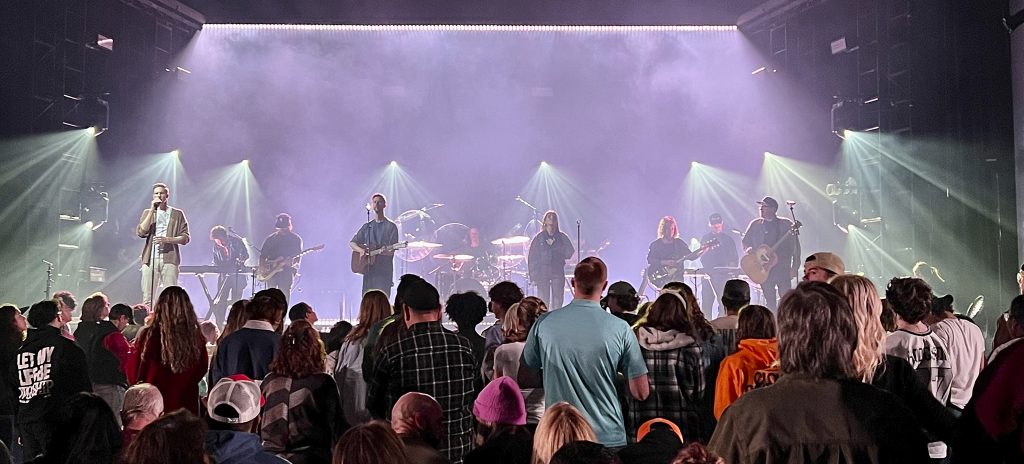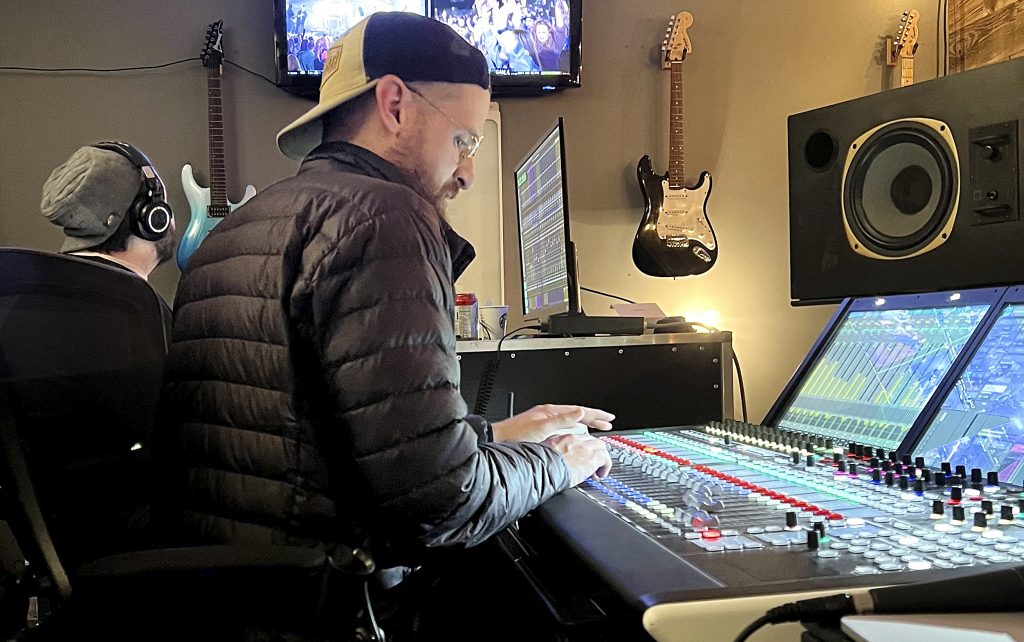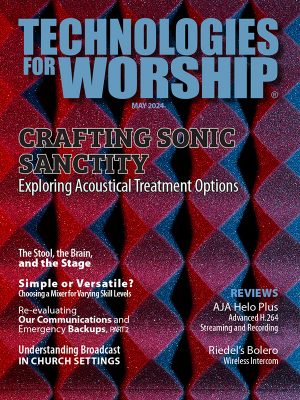
By Tony Staires
Staying curious about how to manage a growing number of audio and video signals more efficiently will necessarily lead heads of audio and video departments in churches to the conclusion that networking their infrastructure offers a lot of benefits.
It is probably safe to say that analog audio setups in churches have all but disappeared, the main reason being that finding vendors that offer large analog audio and video tools has become increasingly difficult. Today’s consoles—even the smallest ones for FOH or monitoring—are digital. Their price tag tells you something about what you can and cannot expect. Of course, some models are excellent value for money, but they will have a hard time rivalling with desks that cost five times as much.
Even though a lot could be said about which console or device offers everything you need, and then some—after all, once we master the basics, we start asking “what if” questions and trying out new workflows—there is no escaping the fact that the price difference between the most popular large desks is relatively small. There is also the odd surprise: the console whose brand name sounds more expensive than the others may turn out to be more affordable and offer a significantly larger feature set.
Let us therefore agree that the overwhelming majority of consoles installed on house-of-worship campuses is digital. Some are connected to AES3-based/analog stageboxes over unwieldy snakes, while others happily accept MADI sources. Combinations of these two are also available. Despite its indisputable qualities, MADI can be thought of as a serial protocol. This may explain why the House-of-Worship community is still very much convinced that serial signals are the only way to get things done.
When looked at from an IP perspective, this may come as a surprise, given that a MADI router will set operators back $15,000, just to do part of what is possible on an IP network.
Do More, Spend Less
Even advocates of open-standards IP readily admit that they did not fully comprehend the elementary power of a network switch until they started using one. When you look at the price of a NetGear M4250 switch, for example, which offers 48 one-gigabit-per-second (1Gbps) ports and a 960 Gbps switching backplane, immense switching and transport power can be had for a tenth of the price a MADI router would cost. “A network switch allows you to transfer an insane amount of information almost for a song,” says Caleb Morris of Morris Collaboratives, a systems integrator headquartered in Irvine, California, who dedicates most of his time to outfitting churches with IP-based audio and video equipment.
And there’s more. The fact that an open-standards IP infrastructure relies on a switching backplane whose size can be expanded quite easily not only opens up a host of additional possibilities but also allows operators to move information to any and all required destinations in one go.
Most of what needs to be done in audio evolves around patching signals both on a console but also between devices directly. Just think of the stageboxes, rigs used for playing back recordings, the various ways of embedding audio, third-party devices operators need to interact with, etc. “The only way you can do that fluently,” says Caleb, “is over IP.” The SMPTE ST2110 protocol gives users a tremendous amount of flexibility.
Some claim that audio signals transported over ST2110 or RAVENNA sound better than with other network protocols. In light of this surprising statement, one operator recently put Dante and ST2110 side by side and concluded that the open standard wins hands down. The reason for this is not quite clear but might be attributed to the clocking system used. It is based on PTP, short for Precision Time Protocol. Something similar seems to apply to RAVENNA versus traditional AES3, arguably one of the hitherto most blameless ways of transmitting audio from one device to another. “It may sound weird to state that the RAVENNA protocol sounds as good—but it does.”
In any case, the affordability, the ability to move things around quickly, and the fact that it sounds exceptional are strong points in favor of ST2110, an open-standards protocol used to transport both audio and video essences, and RAVENNA, a manufacturer-agnostic protocol for transporting audio.
Benefits of IP
Before discussing a few more interesting details, let us briefly look at why IP-based networking is something churches and AV providers have been waiting for without actually realizing it. In today’s communities, a lot of audio and video signals need to be distributed to a variety of locations, both on-site and remotely. While the on-site part could be covered with a serial protocol, the flexibility of such a setup is somewhat static. And once you start contemplating a scenario where the audio console or video processing devices remain in a fixed location, wide-area network traffic (WAN) becomes indispensable. For this, you need devices that support ST2110 or RAVENNA, or both.
Deciding on a different room configuration would require repatching physical cables, which can be relatively painless, but all too often turn into a nightmare. Changing signal routes on a touchscreen, as is possible via the HOME platform for intuitive IP management, is not only much faster, but also more flexible, because routing one signal to several destinations—to the FOH and monitor consoles, to the recording system, and to I/O boxes in several other locations—without changing a single connection is one of the basic features of IP.
Plus, IP makes it easy to embed the required audio into the video footage, which is becoming increasingly important: services are often attended by tens of thousands of worshippers, but there are even more who leverage the church’s online video-on-demand services when this is more convenient.
We should also touch on the fact that an ST2110/RAVENNA network (both protocols run on the same network) allows operators to collaborate from different locations and to share live services among several houses of worship with the possibility for live interaction among them.
Open and Future-Proof
Networking is still fairly new to the audio community at large. “Until this day, students who major in audio do not learn anything about networking strategies,” says Caleb Morris. “As a result, everybody seems to think that you just need to plug everything in for the magic to happen.” This is obviously not the case: some network training is required when you step into an active role at a church or any other venue.
Those who have considered installing a network are probably aware of Dante, a protocol supported by a lot of audio devices. It comes in handy for on-site applications and is a standardized replacement for analog snakes. What most operators don’t know is that an open-standards IP environment is perfectly able to accommodate Dante-compatible devices or even islands. In this way, data originating from a Dante-savvy device can easily be transported to an ST2110- or RAVENNA-compliant destination. Your existing Dante infrastructure thus does not need to become obsolete when you decide to migrate to open-standards IP.
Basing your entire network on Dante—especially if your medium-term intention is to integrate your audio with video on the same network, and to remain flexible with respect to distributed and remote workflows—may be a stretch, though.
For one, the ST2110 and RAVENNA protocols never reduce stream sizes to a point where it just barely works and is unfit for professional results. This is actually a good thing. Open-standards IP either works, or it doesn’t. If it doesn’t, there is usually a good reason—and it is hardly ever the device’s fault but rather the operator’s.
Another important consideration is that ST2110 and RAVENNA are built around a non-proprietary chipset, so that any console, stagebox, processor, and even a computer’s Ethernet port, can network with other IP devices without the need for an expensive proprietary chip. Both RAVENNA and ST2110 effortlessly support high channel counts at 96kHz, which is a must-have for high-quality recordings of either studio or live albums.
Cutting to the Chase
Networking over ST2110 or RAVENNA IP potentially saves thousands of dollars and eliminates single points of failure, thanks to the ability to make the network fully redundant. By this I mean that there are always two routes to a given device or software. If one route drops, the other immediately takes over.
“The way of the future for both audio and video will necessarily be open-standards IP-based. I believe the days of serial signals are numbered,” concludes Caleb Morris. “What is possible IP-wise, both for audio and video, is crucial for where HOW and Contemporary Christian Music are headed. SMPTE ST2110 is the premier protocol that binds audio and video together.”
Anything that can be done to establish ST2110 and RAVENNA in the HOW community will therefore be highly welcome, especially when a switch costing ten times less than a MADI router has a lot more oomph and also handles video.

Tony Staires is the Sales Director, Audio & House of Worship, Lawo North America
Before joining Lawo. Tony Staires was Production Director at Granger Community Church in Indiana. Over the past 20 years, he has also worked in production and AVL integration, with several national broadcast organizations, and as FOH and monitor engineer for Grammy- and Dove Award-winning artists.






